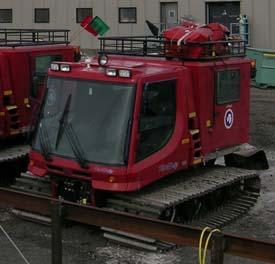
|
|
28 November, 2003
A No-Go for Fang Camp
Well, after five days of waiting and hoping, we’ve been cancelled once
again for our flights to Fang Camp due low-lying clouds around Erebus.
Six of our teammates have been on Erebus for a week now, but the low
visibility has limited their activity as well as ours. Here at McMurdo,
Thanksgiving has been moved to Saturday, which means no flights out
again until Monday. Despite our obvious disappointment, this is the
trade-off for working in such an amazing place. Several teams have now
been stranded here for a week or more so we are in good company.
Despite our failure to leave McMurdo, the day was still eventful. We
were cancelled early, leaving the afternoon free for an adventure. I
heard that Dr. Art DeVries’s team (see 11/27/03 “And
Waiting…”) was heading out to melt a hole in the ice sheet and,
intrigued by this description, Kurt, Shauna, and I went along for the ride.
Into the Pisten Bully we all piled and off we went, bumping along over
the sea ice. While the Pisten Bully (Figure 1) is a neat looking vehicle
and fun to ride in (it turns by holding one track in place and rotating
the opposite track, appearing to turn on itself), it is a slow and bumpy
ride!
We drove out onto the permanent ice sheet in McMurdo sound. The team was
attempting to make a 60-foot hole to the water below. They were using a
contraption that MacGuiver himself would be proud of. A heating element
attached to lashed-together bamboo poles was used to make a hole about 6
inches wide with rough sides and a few twists and turns. The team was
afraid that the camera they would lower into the water would get caught
on one of these bends. To rectify the problem, they had pumped the water
up from the hole as it was being melted, heated it in a big drum, and
then pumped hot water back down the hole to melt the sides smooth. All
in all, it was quite an impressive process. From the surface it didn’t
look like much – one guy lying flat on his stomach on the ice, peering
into the hole, directing a bamboo pole. But when you considered the
effort involved in lugging three generators, several heating elements, a
50-gallon drum outfitted with an outflow valve, and enough gas to run
the generators continuously for 24 hours out to the site, it was quite
an affair. The team started at 10:30 AM and, by our 3:30 PM check-in,
had melted down about 20 feet. All this effort was only a test run for
the 80-foot hole they would melt on Black Island, located across McMurdo
Sound. They needed to be sure that they had all the right equipment and
enough fuel since they would be too far from McMurdo Station to easily
resupply.
We enjoyed our trip out on the ice. It felt good to get out of McMurdo
and hear about another team’s project. On the ride back, I peeked into
Hut #6 (see 11/27/03 “And Waiting…”) to check if a seal
had brought up a big cod, in which case we would have taken it back to
the lab (see 11/25/03 “Still Waiting). But we had no luck
– only two large seals lounging about and snorting loudly in the hole.
Despite my disappointment at staying in McMurdo again, I have to admit
that I am looking forward to Thanksgiving dinner tomorrow afternoon! We
are all certainly thankful that our delay in McMurdo has been a warm and
comfortable one, in contrast to those of the early Antarctic explorers
during the “Heroic Age of Exploration.”
Have a Happy Thanksgiving!

1. Figure 1 – Pisten Bullies are small vehicles with tracks that easily travel over the sea ice and snow. Note the large red dry-bag on top. This is the survival bag described in “Happy Camper School.” The yellow extension cord hanging over the rail is used to plug the vehicles in at night so they start easier in the cold.
Contact the TEA in the field at
.
If you cannot connect through your browser, copy the
TEA's e-mail address in the "To:" line of
your favorite e-mail package.
|
